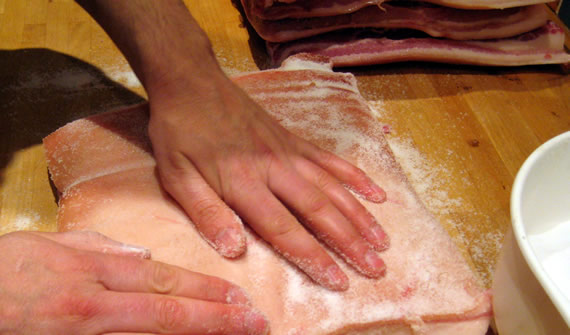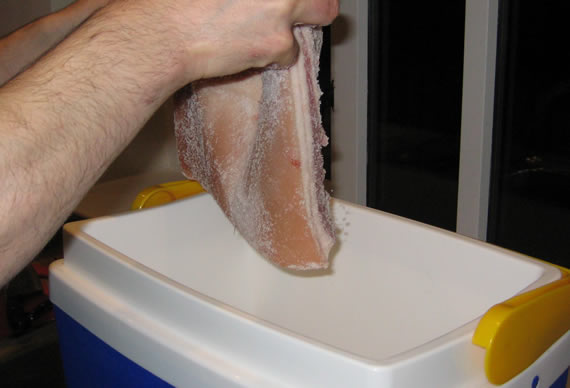Dry-curing bacon
Dry-curing bacon is an extremely easy process. First make-up the cure using the ingredients below. This is a basic cure recipe, if you want to experiment with additional ingredients feel free to do so - herbs, sugars and other dry flavourings give good results.
Basic dry cure ingredients
- 2 kilograms of salt
- 15 grams of saltpetre (optional)
- 200 grams sugar (optional, see below)
- 2 tablespoons black peppercorns (optional, see below)
If you want a recipe based on the weight of the raw meat, follow this rule of thumb:
- 15% salt
- 1.5% sugar
- 0.5 grams of saltpetre per kg of meat
If you're not planning to smoke the bacon then the addition of some molasses or other robust sugar adds some sweetness to the flavour, and can deflect over-saltiness. Similarly the addition of cracked black or mixed peppercorns produces more interest in the flavour. Personally I like smoked bacon, so rarely add anything beyond the salt and saltpetre.
These quantities are approximately what you'll need to get started dry-curing a whole belly from a pig at pork/bacon weight. You'll need to make more of the cure mixture as the curing proceeds, I find it easy to make up a couple of batches in advance and keep them in an air-tight container.
Dry-curing process
To make the cure just mix all the ingredients together. Then take each piece of pork to be cured, a handful of cure mixture, and rub the latter thoroughly into the former. Keep doing this with generous handfuls of cure until the meat is well covered and all surfaces have been worked over - be sure to get cure into every nook and cranny to prevent any spoilage of the meat.
 Rubbing in dry cure
Rubbing in dry cure
Once each piece is done place it in a plastic box - I use a food-grade plastic cool box, with a lid and a handle. Something very like this Thermos cool box. Once all the meat has been processed and stacked in the box put a lid or secure cover on it and leave in a cool place, such as a garage - one of the benefits of using a cool box is that you can use frozen blocks to keep the temperature down.
 Pop it into the coolbox
Pop it into the coolbox
Every 24 hours for the duration of the curing period, remove the meat from the box and pour away the liquid that will have leached from the pork - you'll find a huge amount leaches in the first 24 hours, then progressively less. While the pork is out of the box rub more cure mixture into the meat, and re-stack in the box reversing the order, so those pieces which were covered by liquid last time are on top this time.
Duration of curing
We dry-cure our bellies for 5-6 days, and loins for 4-5 days. You can cure for up to 2 weeks, which will increase the time the bacon will keep for, but will also increase the saltiness of the finished product.
Once the curing period is completed, soak the cured pork in clean, fresh, water for 2 hours, discard the water, then soak for a further hour in clean water. You'll find a huge amount of conflicting advice about how long to soak dry-cured bacon for, but this is what we've found works best for us - it results in a bacon that's not too salty for our palate and keeps very well in the freezer. Your experiences may differ, so don't be afraid to experiment.
After rinsing, the bacon needs to be dried to allow a pellicle to form on the surface. The pellicle is a layer of protein which serves 3 purposes - it prevents the fat in the meat from rising to the surface and spoiling; it provides a surface to which smoke molecules will cling more effectively; lastly it seals in moisture, preventing the bacon from drying out completely.
We hang our bacon in a cool out-building, using butchers' hooks, for between 24 and 48 hours, until the shiny, slightly tacky pellicle is well-formed.
At this stage you have green bacon, and if you don't want to smoke it, it's ready to eat and store.
- Previous « Principles of curing
- Next Wet-curing bacon »

About Dan Champion
A self-confessed geek, Dan would spend 20 hours per day in front of a computer if he didn't live on a 12-acre smallholding in the east of Scotland (and if his wife would let him). He also built this website.
Further Reading
 Le Charcutier Anglais: Tales & Recipes of a Gamekeeper Turned Charcutier Berry Marc-Frederic |  Making Your Own Cheese: How to Make All Kinds of Cheeses in Your Own Home Paul Peacock |  Cheesemaking and Dairying: Making Cheese, Yoghurt, Butter and Ice Cream on a Small Scale Katie Thear |  The Sausage Book Paul Peacock |  Maynard: Secrets of a Bacon Curer Maynard Davies |










